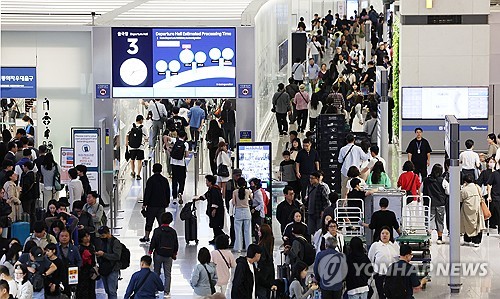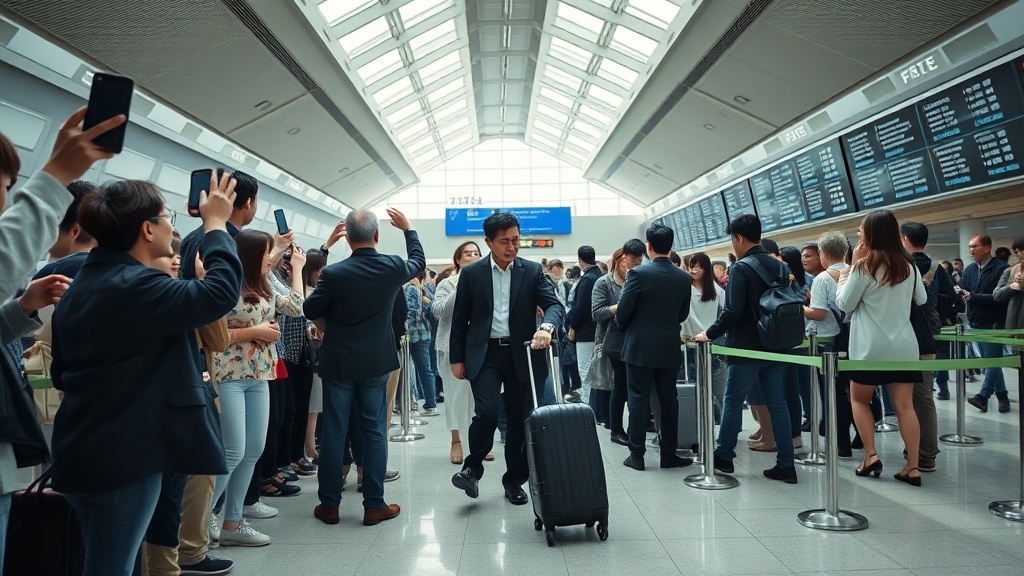Summary: Clashes between fandoms, private security, and airport operations often harm ordinary passengers.
Summary: Improved crowd control rules and clearer norms are needed for safety and public order.
Summary: Solutions should combine advance coordination, tighter access control, and education for fans and security staff.
Fans at the airport: whose rights come first?
Overview
The scene is chaotic.
At Incheon International Airport during a recent holiday, fans, reporters, and ordinary travelers converged on the same paths and created a major disturbance.
This is more than a noisy episode; it is a clash over safety and rights in a public place.
Airports are designed to prioritize aviation security and passenger safety. However, the global spread of K-culture (K-pop and Korean drama) has made large crowds around departing celebrities a recurring problem.
The background is clear.
More international schedules for entertainers, the public nature of departure times, and collective fandom behavior combine to make airport crowding structural rather than incidental.
Meanwhile, limits in how private security firms and airport authorities coordinate make it hard to protect normal passenger flow.
Therefore, the issue calls for social agreement and institutional fixes beyond simple crowd management.

The photo looks familiar.
But the damage behind the image is hard to describe fully.
Delays for ordinary travelers, inconvenience to children and older people, and frequent minor physical collisions expose real weaknesses in public safety.
Why does this keep happening?
Causes
The causes are multiple.
First, K-pop and K-drama have gone global, so artists travel abroad more often.
Second, publicly known departure schedules encourage fans to gather, and fandom culture can be intensely mobilizing.
Third, airport crowd-control systems and the ability of security firms to react quickly to sudden scenes are often inadequate.
In this setting, physical interventions by security and overexcited fan behavior amplify each other.
In the end, the harm often falls on unrelated travelers, not the celebrities or their fans.
We must remember that airports must serve all users safely and efficiently.
For fans: free expression and the right to cheer
It is a fan’s right.
Fans gathering at an airport to cheer a celebrity is a form of personal expression and group identity.
Supporters say airport send-offs help drive K-culture’s growth.
Meeting a favorite artist in person strengthens fans’ identity and can give artists emotional support.
Seen this way, celebrities using an airport as a place to connect with the public looks natural.
Some fans also try to keep order.
There are reports of voluntary efforts to keep passages clear and of fan-made rules for good behavior.
Supporters argue these groups should be treated as cultural participants and consumers rather than troublemakers.
They also claim that fan activities shared on social media can boost national image and cultural exports.
However, this argument risks overlooking real conflict.
If fandom claims are defended too strongly, necessary airport rules and other passengers’ rights may be sidelined.
Still, proponents prefer negotiation and advance agreement to blunt enforcement—things like designated waiting zones, safety training, and stewarding resources agreed by fans, agencies, and airports.
These measures aim to balance fan autonomy with public order.
“We came to cheer. But we want to keep order, too.”
There are reflective voices inside fandoms.
Some fans admit that heated behavior hurts their group’s image and are pushing for self-regulation and education.
So even within supporters there is growing acceptance that practical safety measures are necessary.
Against: passenger harm and airport safety
Rights are being infringed.
An airport is not meant to serve one group’s cheering events.
Critics say crowds around departing celebrities seriously block movement and risk passengers’ safety.
Airports require strict procedures—security checks, baggage screening, boarding—and extra crowds reduce operational efficiency.
Reports of delayed departures, blocked walkways, and even physical injuries have accumulated.
This view puts public interest first.
All passengers deserve safe and timely travel, and a celebrity’s fan crowd should not take precedence.
Older people, families with infants, and travelers on business can suffer real harm when unexpected congestion occurs.
These people lose time, face stress, and sometimes miss flights—consequences that deserve institutional protection.
Excessive force by private security can also become a legal issue.
Coercive or violent control at airports raises concerns under security and public-safety laws, and some incidents have led to punishments.
Critics point to failures by airport authorities to plan ahead as part of the problem.
Attempts to create separate exits or special departure windows for celebrities have sometimes been dropped amid controversy over unfair treatment.
“One person’s ‘it’s okay’ becomes everyone’s risk.”
Opponents therefore call for clear rules and strict enforcement.
Proposals include keeping departure schedules secret when needed, banning fan gatherings in certain airport areas, and imposing strong administrative and financial penalties for violations.
They argue that only fair, consistently applied rules protect public spaces.
Practical steps and policy options
There are solutions.
Practical measures include:
First, review how departure times are publicized and require pre-arranged agreements between agencies and airports when disclosure is necessary.
Second, clearly define and mark no-gathering zones inside airports and strengthen signage and staff guidance.
Third, require security firms to train staff on airport rules and nonviolent crowd management to prevent physical clashes.
Also, make official channels for fan coordination.
A standing committee with fan representatives, agencies, and airport officials can set rules in advance and publicize them to reduce conflict.
At the same time, protect ordinary passengers by preserving separate routes, assigning reserve staff, and providing real-time announcements.
Technology can help too: congestion prediction systems and route-management apps can encourage passenger dispersal.
Legal and administrative tools are needed as well.
Set clear fines and administrative penalties for behavior that disrupts airport order, and investigate and punish illegal practices by security firms.
These steps can produce short-term deterrence and, over time, create conditions for fandom culture to coexist peacefully with public spaces.
Comparisons and international lessons
Other countries do it differently.
Some overseas airports have established good models of advance coordination and control.
For example, some designate event-style waiting areas for star departures and use physical barriers plus clear rules to limit access.
Those cases show that pre-planning and communication can work better than punishment alone.
But cultural differences matter.
Korean fandoms are often highly organized, passionate, and quick to mobilize through social networks.
So foreign models should be adapted, not copied wholesale.
Options to test include formalizing fan self-regulation and experimenting with shared responsibility models between agencies, fans, and airports.
Finding balance
The key is balance.
If we fail to balance fans’ expression with ordinary passengers’ public-use rights, conflicts will keep repeating.
Shared responsibility—between security, fans, and airport authorities—and advance planning are essential.
Short-term enforcement must be paired with long-term cultural agreements.
Safety and respect must come first.
Rules alone cannot solve everything; education, communication, and technical support are also required.
Airports should create physical and administrative measures to protect travelers, and fandoms should adopt norms that promote responsible behavior in public spaces.
Only this combined approach can make coexistence realistic.
Conclusion
The point is simple.
Crowds around departing celebrities are not just a fan phenomenon; they raise questions about airport publicness, safety, and social agreement.
Advance coordination, careful schedule control, standardized security and airport procedures, and fan education should proceed together.
Without that, clashes and harm to ordinary travelers will continue.
Finally: which approach seems more reasonable to you—allowing fan presence under strict rules, or strong measures such as withholding public schedules and tighter bans on gatherings?
